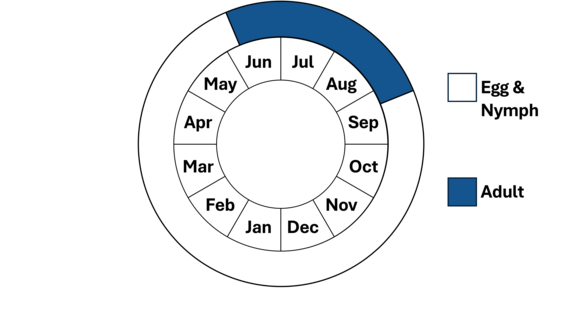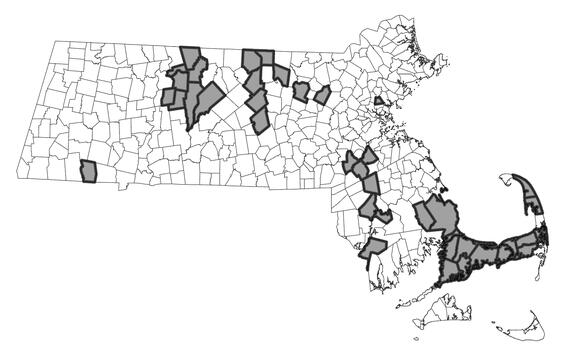- Scientific name: Celithemis martha
Species of Greatest Conservation Need (MA State Wildlife Action Plan)
Description

Male Martha's pennant
The Martha’s pennant is a small, slender insect belonging to the order Odonata, suborder Anisoptera (the dragonflies), and family Libellulidae (the skimmers), the largest dragonfly family in North America. The species belongs to the genus Celithemis (the small pennants) characterized by their long and variably marked wings combined with a small thorax and abdomen. For Martha’s pennant, a mature male has a black thorax and abdomen with some blue-white pruinosity, brown eyes, and with dark basal hindwing spots. Females and immatures are marked with yellow on thorax and abdomen with dorsal spots on segments three to seven, basal hindwing patches of yellow and black, and brown to dull yellow eyes.
Adult Martha’s pennant range from 25-33 mm (1-1.3 in) in length. Fully developed nymphs and exuviae may range from 13-17 mm (~0.6 in).
Three other species of Celithemis occur in Massachusetts are most similar in appearance to Martha’s pennant. The adults can be distinguished by its hindwing basal spots, not present in this pattern in other small pennants. For nymph and exuviae identification refer to keys in Tennessen (2019).
Female Martha’s pennant.
Life cycle and behavior

The egg and nymph life stages of Martha’s pennant are fully aquatic. The cryptic nymphs are predators likely feeding on smaller invertebrates. Nymphs undergo several molts (instars) for probably 1 year until they are ready to emerge as winged adults. Nymphs emerge up onto emergent vegetation or other substrate primarily in June and July. When the nymph reaches a secure substrate, the adult begins to push itself out of the exoskeleton. As soon as the abdomen and wings are fully expanded, the adult takes its first flight. This maiden flight usually carries the individuals up into surrounding forest or other areas away from wetlands, where they spend several days maturing and feeding and are somewhat protected from predation and inclement weather. Adults occupy nearby fields and wetlands foraging for smaller insects and perch on the tips of vegetation stalks. Mature males patrol shorelines over emergent vegetation seeking females in the morning hours. Females likely occupy surrounding forested uplands. The height of breeding in Massachusetts probably occurs in July and August. Following mating, the female oviposits eggs in the water while the male is in tandem. Martha’s pennant emerges in June and are on the wing until early September.
Male and female Martha’s pennant in tandem. Oviposition occurs in this configuration.
Distribution and abundance
Martha’s pennant has a northeastern distribution from Virginia to Nova Scotia along the Atlantic coastal plain. The species has been recorded in all New England states except Vermont. In Massachusetts, the species occurs in the Farmington, Middle Connecticut, Millers, Chicopee, Nashua, Concord, Mystic, Neponset, Taunton, and Cape Cod watersheds. Most observations are from the southeastern part of the state but also include scattered sites across north-central Massachusetts. As with a few other coastal plain odonate species (e.g., Enallagma pictum, E. laterale), Martha’s pennant may be undergoing a range expansion via climate change as seen in recent New Brunswick records (McAlpine et al. 2017). This may also the case in Massachusetts with more recent observations in north-central Massachusetts.

Distribution in Massachusetts.
1999-2024
Based on records in iNaturalist, Odonata Central, and Natural Heritage databases.
Habitat
Martha’s pennant inhabits lentic waterbodies typically with acidic waters, sandy substrates, and emergent and floating-leaved aquatic vegetation. Lentic waterbodies include coastal plain ponds and impoundments. Nymphs are aquatic and inhabit aquatic vegetation beds and mud bottoms with organic matter. Adults also occupy surrounding uplands, including forests, fields, and sunny patches.
Healthy habitats are vital for supporting native wildlife and plants. Explore habitats and learn about conservation and restoration in Massachusetts.
Typical coastal plain pond habitat with emergent and floating-leaved aquatic vegetation suitable for Martha’s pennant.
Threats
The major threats to Martha’s pennant are shoreline and wetland degradation and loss. Shoreline development may eliminate nearshore/littoral zone and riparian vegetation and harden shorelines through construction of buildings, roads, and other human constructions. Further, shoreline development facilitates increased nutrient and contaminant inputs (e.g., road salts, septic, fertilizer), sedimentation, surface and groundwater withdrawals or water level alteration (e.g., winter drawdown), pesticide use, introduction and spread of invasive species (aquatic vegetation and animals), and recreational activity (e.g., off-road vehicles, boat wakes). These activities lead to wetland/pond degradation that accelerates eutrophication, degrades water quality, and alters or eliminates aquatic vegetation composition required for Martha’s pennant including floating-leaved vegetation. Invasive species including Phragmites can replace native vegetation creating unsuitable habitat conditions. In addition, climate change may create unfavorable conditions, including prolonged drought and high-water events, that in combination with ongoing habitat degradation (water withdrawals, nutrient inputs) can increase cyanobacteria blooms, reduce habitat, and alter aquatic vegetation composition unsuitable for the species. Since this species occasionally occupies impoundments, unmanaged dam removals may locally extirpate the species from sudden dewatering and habitat loss. High-impact recreational use such as off-road vehicles driving through pond shores, which may destroy breeding and nymphal habitat, and motorboats, whose wakes swamp delicate emerging adults, are also threats. Since immature adults spend a period of several days or more away from the pond maturing, it is important to maintain natural upland habitats adjoining the breeding sites for roosting and hunting. Without protected uplands the delicate newly emerged adults are more susceptible to predation and mortality from inclement weather.
Conservation
Survey and monitoring
Standardized and targeted surveys for Martha’s pennant is needed to determine its status in Massachusetts. Surveys should target historical and new wetland sites to determine species occupancy and population status. Surveys for exuvia and adults are likely to be more effective for detection compared to either one alone. Exuviae surveys should target the species emergence period in mid-late June to maximize detection. Adult surveys should target stream and streambank habitats during their flight period during standardized weather and time windows to maximize species detection. Multiple site visits (e.g., ≥3) may be required to detect this species. Routine monitoring of prioritized sites is needed to estimate occupancy trends overtime.
Management
Protection and restoration of shoreline/littoral zone, riparian, and upland habitat is critical for Martha’s pennant persistence in Massachusetts. Actions that can improve or prevent habitat degradation include: reduction of nutrient, agricultural and road runoff; minimization of water level alteration that impacts native aquatic vegetation; minimization of groundwater withdrawals particularly during drought periods; prevention and management of nonnative aquatic vegetation species; development of best practices for herbicide use; limitation and enforcement of off-road vehicles on shoreline habitat; management of dam removals to mitigate for potential habitat and population loss; and connection between ponds and other pond complexes.
Research needs
Through standardized surveys, effort is needed to define habitat requirements, distribution, relative abundance, and potential breeding sites in Massachusetts. Research effort is needed to estimate detection and occupancy rates and how other environmental variables (e.g., sample timing, weather) affect these rates. Other research efforts include projections of species distribution under climate change scenarios and climate vulnerability analysis in Massachusetts, estimation of physiological tolerances to insecticides and herbicides, and impacts of non-native fish and aquatic vegetation on populations.
References
Brown, V.A. 2020. Dragonflies and Damselflies of Rhode Island. Rhode Island Division of Fish and Wildlife, Department of Environmental Management, West Kingston RI.
Lam, E. Dragonflies of North America. Princeton NJ: Princeton University Press, 2024.
McAlpine, D.F., H.S. Makepeace, D.L. Sabine, P.M. Brunelle, J. Bell, and G. Taylor. 2017. First occurrence of Enallagma pictum (Scarlet Bluet) (Ononata: Coenagrionidae) in Canada and additional records of Celithemis martha (Martha’s Pennant) (Odonata: Libellulidae) in New Brunswick: possible climate-change induced range extensions of Atlantic Coastal Plain Odonata. J. Acad. Entomol. Soc. 13: 49-53.
Nikula, B., J.L. Ryan, and M.R. Burne. A Field Guide to the Dragonflies and Damselflies of Massachusetts. 2nd ed. Massachusetts Natural Heritage and Endangered Species Program, 2007.
Paulson, D. Dragonflies and Damselflies of the East. Princeton NJ: Princeton University Press, 2011.
Tennessen, K. Dragonfly Nymphs of North America: An identification guide. Springer, 2019.
Contact
| Date published: | April 1, 2025 |
|---|